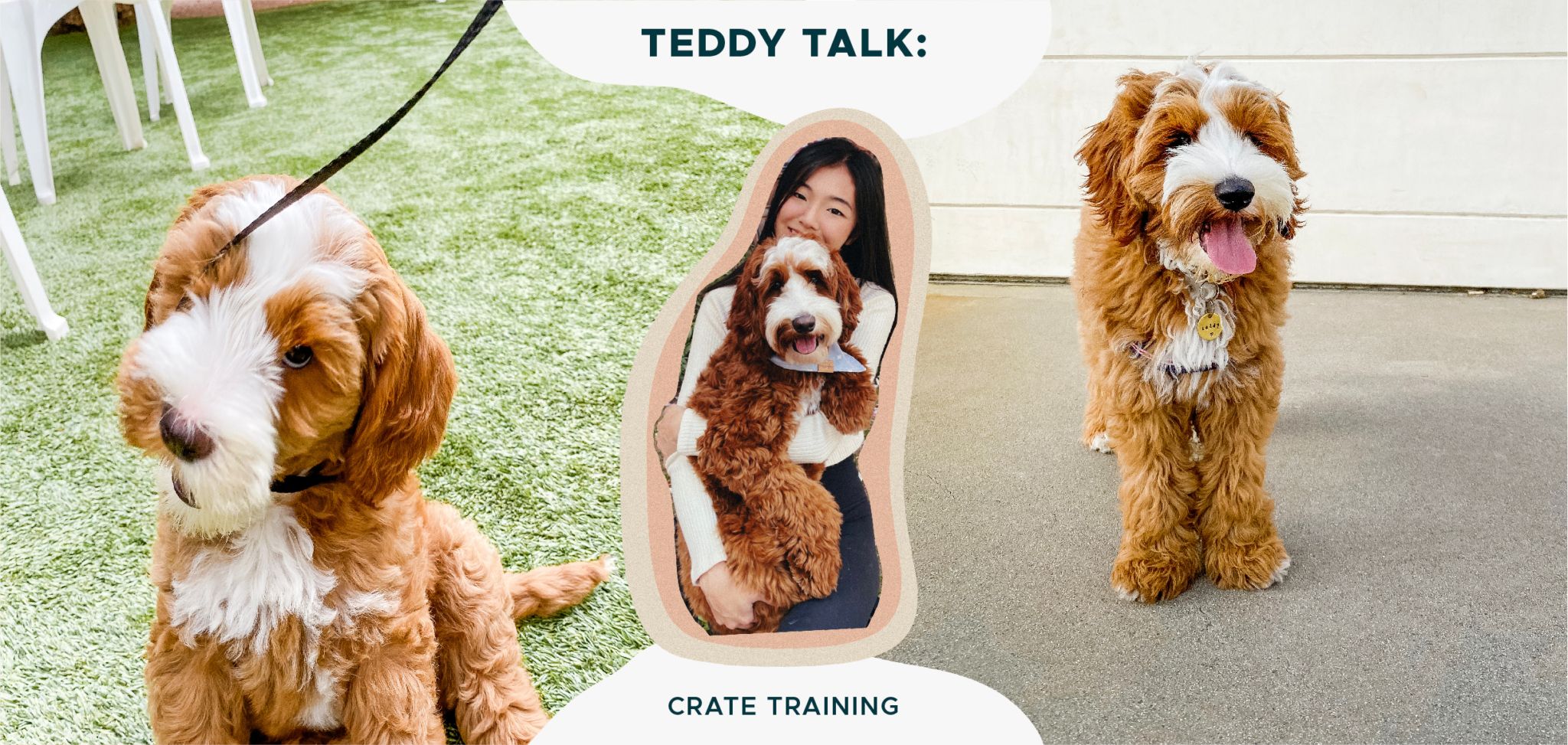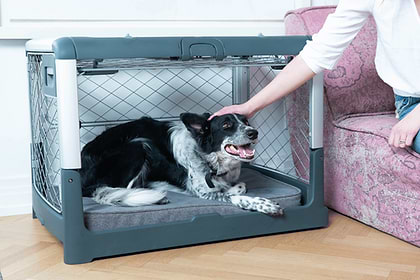Before bringing my doodle Teddy (@ourdoodteddy) home, crate training felt like a huge, monstrous task that would be almost impossible to tackle. I was stressed, to say the least. However, after doing countless hours of research and using all the resources I could possibly find, it seemed a bit more doable on my end and I found a bit of confidence.
I wanted to share some things that Teddy and I did in order to successfully navigate crate training. I hope it’ll bring you the same confidence and reassurance that the resources I found online did for me!
Prepare beforehand
This helped me a TON! Bringing home a new puppy is overwhelming already, so I made it a point to do as much prepping and planning before Teddy came home. Aside from the typical puppy proofing our house, setting up vet appointments, etc, something I did that helped ease into crate training was sending Teddy’s breeder a puppy blanket.
I made sure to ask our breeder to place the puppy blanket in Teddy’s living space with his siblings and mom in hopes that it would rub as much of the scent onto the blanket as possible. We brought the blanket home with him and made sure to place it straight into his crate! He had the blanket inside his crate from day 1, and it really did seem to comfort him while he was adjusting to his new home and crate. I ended up also giving him a shirt of mine that I wore frequently as PJ’s!
Everything you can check off your to-do list before your pup comes home helps, that way you can spend more time together and less time worrying about the details!
Follow a schedule
After doing some research, I quickly learned that like humans, puppies thrive off of routine! So, I went ahead and created a schedule for Teddy and me to follow once he came home. Below is the nighttime routine that I had set for Teddy—it worked super well and I’m so glad that I had this prepared!
Yes, waking up in the middle of the night to go potty was dreadful. I was basically a walking zombie for a couple of days. BUT! It was 100% worth it. Doing that taught him that he does not have to cry in the middle of the night to get my attention to go potty. I was able to earn his trust, and he quickly learned that I would take responsibility and take him potty at set times throughout the night.
NOTE: Teddy stopped needing to go potty throughout the night at 12 weeks old. He went once at 10 pm, once at 6 am, and slept in until 8:30 am. Now, as a 1-year-old “puppy”, he would sleep in until 1 pm if we let him!
Have patience
A lot of first-time puppy owners have the misconception that crate training will happen overnight. I was guilty of this, too. During the first few days of having Teddy home, I learned that having patience is key and taking baby steps is so important...especially when it comes to crate training.
It is super important to make sure that your pup is comfortable in and around the crate BEFORE having to spend a whole night in it. Again, taking it slow is important and will be helpful when it comes to having an easy first night home. I made sure to keep in mind that Teddy is only 8 weeks old, in a completely new environment for the first time since being born, and away from his siblings and mom for the first time.
Positive Associations & Desensitization
This goes hand in hand with having patience and taking baby steps. Creating positive associations with the crate and desensitizing Teddy to the crate was something I was extremely focused on, even before he came home.
When doing research for breeders, I made sure to pay close attention to the training and desensitization that different breeders did for the pups before they went to their forever homes. I was pleasantly surprised to read that our breeder does expose her puppies to crates and desensitizes the puppies to the routine of being in and sleeping in one. I really do believe that this helped Teddy tremendously as he was already familiar with the idea of a crate before he came home.
Once Teddy came home, we continued the positive associations and desensitization towards his crate. We started off by ALWAYS leaving the crate in our main living room during the daytime, and making sure that it was always easy for Teddy to go in and out as he pleased. Whenever he did step inside his crate on his own, we made sure to praise and reward him with tons of yummy treats. For the first week or two, we even had special “crate time only” treats for Teddy. He would get his most favorite chews and treats inside the crate, and only inside the crate! This helped him associate the crate with happiness and positivity.
We also made sure to feed his meals in his crate. We started off by leaving the door wide open during meal times, and slowly worked up to being able to shut the door completely while he finished his meals. Once we were able to work up to that, we made a point to never open the crate door for him unless he was sitting nicely without whining to be let out. This taught him that whining will never get him what he wants— patience and sitting politely will!
Playing crate games had to be Teddy’s favorite form of desensitization (aside from eating yummy treats, of course!). We played many rounds of fetch to help him get desensitized to being inside the crate. We would throw his favorite ball or stuffed animal inside the crate, have him go and grab it, bring it back, and repeat the process over and over again.
Training aids
Teddy and I both wouldn’t have survived crate training without some training aids! I was that eager new puppy mom that bought anything and everything for Teddy. I’ve done my fair share of testing out training aids for crate training, and these are the few that I’ve recommended over and over to my friends and family!
Yummy treats are the perfect way to help your pup associate the crate with happy, positive memories! We used the Groov to create recipes out of Teddy’s favorite fruits and treats. Some of our go-to’s are bananas, strawberries, blueberries, mangoes, goat’s milk, and plain Greek yogurt.
Pet Parent Pro Tip: put it in the freezer for 2-3 hours to increase the time your pup takes to finish it! Teddy is now 1 and to this day, he goes nuts whenever he sees us pull out the Groov from the freezer.
SmartPetLove Snuggle Puppy:
We got Teddy a Snuggle Puppy, which is essentially a stuffed animal puppy that comes with heating pads and a little heartbeat device so that your puppy feels like they are sleeping with their littermates. It provides them with a sense of comfort and safety! Teddy still has his Snuggle Puppy today and he very much loves it—it’s one of his most special toys!
White Noise Machine:
Puppies and newborn babies are similar in more ways than you’d think, which is why I went ahead and purchased a white noise machine for Teddy. We still sleep with it turned on every night, and it became almost like a bedtime routine for us to turn that on. Whenever it’s on, he knows that it’s time to wind down and head to bed. When Teddy was a young puppy, the white noise machine really helped soothe him and drown out all the outside noises that may be a distraction while trying to sleep.
Cooling Blanket:
This will be both you and your puppy’s best friend, especially if your pup comes home during the warmer months! I got Teddy a cooling blanket because he came home to sunny Southern California in June. I was super worried about him overheating in his crate and wanted to make sure that he was as comfortable as possible! Little did I know that the cooling blanket would be his most favorite thing...ever! We made sure to only place the cooling blanket inside his crate, so he knew where to go when he wanted a nice cool-off. We found him moving himself into his crate after a few days because he quickly realized that the crate with the cooling blanket was the coolest place to be!
Crate training Teddy was definitely a long journey. It takes a lot of time, effort, and patience. But it was 100% worth it and I am so glad I put in the time to make his crate a safe, comfortable space. Don’t be discouraged if your pup isn’t getting the hang of it after a day or two. Remember, they’re so young and so new to everything! Taking baby steps is key, and remember to cherish every moment with your little one. They grow up SO fast! I hope our crate training tips and tricks gave you some sort of guidance and reassurance. You can do this!

Rosie Jang
Rosie is a marketing associate at Diggs and a dog mom of 1 year to her puppy Teddy. She loves sharing all the tips and tricks she comes across while navigating life as a first time dog mom. When she isn't working, you can find her walking Teddy over to Boston Commons, visiting Trader Joe's (yes, just for fun), or snapping some cute photos and videos for Teddy's Instagram (@ourdoodteddy).
You might also like
Crate training tips, stories and inspiration
View all blogsIn Your Diggs
Share your photos with #DiggsPet and tag us @DiggsPet on IG and TikTok.



